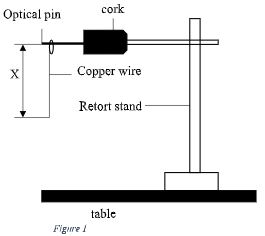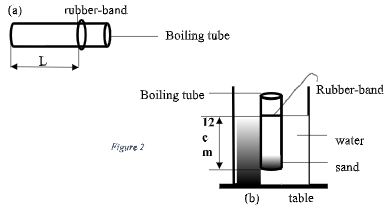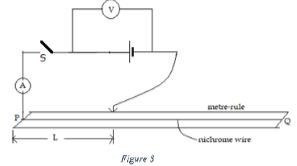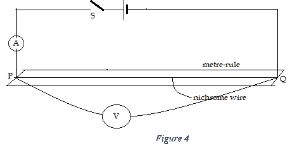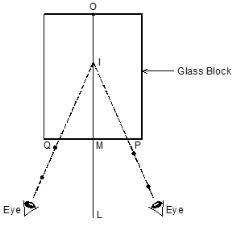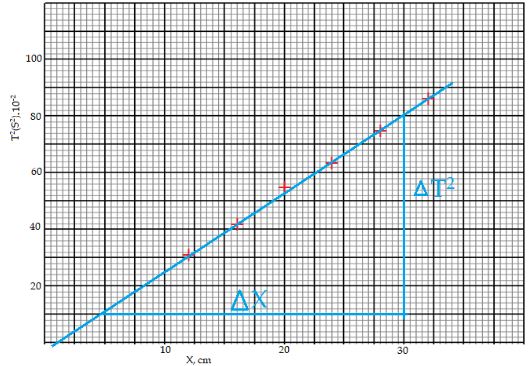Questions
INSTRUCTIONS TO CANDIDATES
- You are supposed to spend the first 15 minutes reading the whole paper carefully before commencing your work.
- Candidates are advised to record their observations as soon as they are made.
- Marks are given for observation actually made, their suitability, accuracy and the use made of them.
QUESTION ONE
PART A
You are provided with the following:
- Copper wire
- A retort-stand, boss and clamp
- An optical pin mounted on a cork
- A stop watch
- Wire cutters (to be shared)
- A metre-rule or half-metre rule
- Clamp the cork so that the optical pin is horizontal. Hang the copper wire from the pin by the loop as shown in figure 1. Ensure the wire is straight and the length X between the lower tip and the optical pin is 32 cm. If the length exceeds 32 cm reduce by cutting at the lower tip using the wire cutters provided.
- Displace the lower tip of the wire slightly in a plane perpendicular to the optical pin and then release it. Measure the time t for 20 oscillations of the wire and record the value in table.
- Repeat the procedure in (b) above for other values of X shown in the table. (Note that each length X is obtained by cutting off an appropriate length from the lower tip of the wire. For example, to get X= 28cm cut off 4 cm from the lower end). Complete the table. (6 marks)
Table 1
Length X (cm) 32 28 24 20 16 12 Time t for oscillations (S) Period (T = t/20) T2(S2) - Plot a graph of T2 (y- axis) against X (5 marks)
-
- Determine the slope, S, of the graph (3 marks)
- Obtain the value of k in the equation: S= 8π/3K (2 marks)
PART B
You are provided with the following:
- A cylindrical container
- Some water
- A stop watch
- A metre ruler or half metre rule
- A boiling tube
- Some sand
- A rubber band
Proceed as follows:
- Tie the rubber band round the boiling tube so that it is at a distance L= 12 cm from the bottom of the tube (see fig 2. a). Pour water into cylindrical container until the level is about 2.0 cm from the top of the beaker. Float the boiling tube in the water in the container. Add sand gradually into the boiling tube until the tube sinks to the 12 cm mark. See figure 2 (b).
- Depress the boiling tube slightly and release so that is oscillates vertically without touching the sides of the container. Measure and record in table 2 the time t1, for five oscillations of the boiling tube, Repeat the procedure two more times to obtain t2, and t3 and record the values in table 2. Complete the table. (3 marks)
Table 2
t1 (S) t2 (S) t3 (S) Average, t (S)
t = t₁ +t₂ + t₃
3T=t/5 (s) - Evaluate PT = 40L given that L is the length of the tube up to the rubber band in (f) and T is the value obtained in (g) above. (1 mark)
P = _________
QUESTION TWO
You are provided with the following apparatus:
PART A
- Constantan wire SWG 28 mounted on a mm scale
- Ammeter (0 – 1) A
- Voltmeter (0 –2.5) V
- A jockey
- 6 connecting wires with crocodile clips
- A switch
- A new dry cell and a cell holder
- Micrometer screw gauge to be shared
Proceed as follows:
- Connect the apparatus provided as shown in the circuit below. Measure the voltmeter reading, E when the switch is open.
E = ………………… (1 mark)
Figure 3 - With the crocodile clip at L = 10 cm, close the switch S and record the ammeter and voltmeter reading.
A = …………………………. (1 mark)
V = ……………………. (1 mark) - Repeat the procedure in (b) for other values of l = 15cm, 20cm, 25cm, 30cm, 35cm and record the readings in the table below. (5 marks)
Table 3
Length. L. (cm) 10 15 20 25 30 35 Voltmeter reading, V (volts) Ammeter reading, I(A) - Given that V = X – 0.3.I, determine the value of X when L is 20cm (2 marks)
- Measure the diameter d of the wire x using the micrometer screw gauge.
d = ___________________________ m (1mark) - Dismantle the apparatus and set up the circuit as shown below
- Close the switch S and record the ammeter and the voltmeter readings
I = __________________________ A (1 mark)
V = __________________________ V (1mark)
Hence find R, the resistance of the wire.
R = ___________________________ (1mark) - Given that: R = 4ρd2 , determine ρ (2 marks)
- Close the switch S and record the ammeter and the voltmeter readings
PART B
You are provided with the following apparatus.
- Rectangular glass block
- 3 optical pins
- A soft board.
- A plane paper
- 4 paper pins.
- Four tuck pins
Proceed as follows:
- Using the tuck pins, fix the plane paper on the soft board.
Place the rectangular glass block in the middle of the plane paper and trace its outline (as shown in figure 5). Using a pencil. Remove the block. - Construct a perpendicular line LMO bisecting the shorter sides of M and O.
Mark points P and Q such that PM = MQ = 2cm.
Measure OM............................................................................. (12 mark) - Place the plane paper on the soft board and carefully replace the glass block so that it fit the outline. Press the object pin on O such that it is upright and touching glass block and the second pin on P also upright and touching the block.
- Press the third pin P1 a short distance from the block such that P1, P and I lie on a straight line when viewed through the block with one eye. I is the image of the object pin O.
- Repeat the experiment with now on Q. Press the third pin P² a short distance from the block such that when viewed P², Q and I lie in a straight line.
- Remove the pins and glass block; draw the lines P1PI (PI dotted) and P2 QI (QI) doted meeting OM at I.
IM = ..........................................................................................cm (12 mark) - Using the above information, determine, k, given that: A=lk , where l is the length OM and A is the length IM (1 mark)
- State the significance of k (1 mark)
NB - Hand in your work on the plane paper as proof of having done the experiment. (1 mark)
Confidentials
Every candidate is expected to be provided with the following apparatus:
QUESTION ONE
You are provided with the following:
- Copper wire (approximately 35 cm long and 1 mm thick)
- A retort-stand, boss and clamp
- An optical pin mounted on a cork
- A stop watch
- Wire cutters (to be shared)
- A metre-rule or half-metre rule
- A cylindrical container (approximate height of 20 cm)
- Some water
- A stop watch
- A metre ruler or half metre rule
- A boiling tube (approximate: diameter of 2.5 cm and height 15 cm)
- Some sand
- A rubber band
QUESTION TWO
- Constantan wire (of approximate 0.33mm thick) mounted on a mm scale
- Ammeter (0 – 1) A
- Voltmeter (0 –2.5) V
- A jockey
- 6 connecting wires with crocodile clips
- A switch
- A new dry cell and a cell holder
- Micrometer screw gauge (to be shared)
- Rectangular glass block (approximately 10cm by 6 cm by 2 cm)
- 3 optical pins
- A soft board.
- A plane paper
- 4 paper pins.
- Four tuck pins
- 30 cm ruler (to be provided by the candidates)
Marking Scheme
QUESTION ONE
PART A
You are provided with the following:
- Copper wire
- A retort-stand, boss and clamp
- An optical pin mounted on a cork
- A stop watch
- Wire cutters (to be shared)
- A metre-rule or half-metre rule
- Clamp the cork so that the optical pin is horizontal. Hang the copper wire from the pin by the loop as shown in figure 1. Ensure the wire is straight and the length X between the lower tip and the optical pin is 32 cm. If the length exceeds 32 cm reduce by cutting at the lower tip using the wire cutters provided.
- Displace the lower tip of the wire slightly in a plane perpendicular to the optical pin and then release it. Measure the time t for 20 oscillations of the wire and record the value in table.
- Repeat the procedure in (b) above for other values of X shown in the table. (Note that each length X is obtained by cutting off an appropriate length from the lower tip of the wire. For example, to get X= 28cm cut off 4 cm from the lower end). Complete the table. (6 marks)
Length X (cm) 32 28 24 20 16 12 Time t for oscillations (S) 18.56 17.37 15.87 14.94 13.09 11.21 Period (T = t/20) 0.9280 0.8685 0.7935 0.7470 0.6545 0.5605 T2(S2) 0.8612 0.7543 0.6296 0.5580 0.4284 0.3142 - Plot a graph of T2 (y- axis) against X (5 marks)
-
- Determine the slope, S, of the graph (3 marks)
(if from graph, L = 0, then there is no slope)
- s=∆T2∆X=0.80-0.1030-5;=0.028;s2/cm; = 2.8s2/m
correct substitution; correct evaluation; correct units in s2/cm or s2/m
- s=∆T2∆X=0.80-0.1030-5;=0.028;s2/cm; = 2.8s2/m
- Obtain the value of k in the equation: S= 8π3K (2 marks)
- 2.8= 8×3.142 ;≡k=2.992m/s2; correct substitution and correct answer with units
3k
- 2.8= 8×3.142 ;≡k=2.992m/s2; correct substitution and correct answer with units
- Determine the slope, S, of the graph (3 marks)
PART B
You are provided with the following:
- A cylindrical container
- Some water
- A stop watch
- A metre ruler or half metre rule
- A boiling tube
- Some sand
- A rubber band
Proceed as follows:
- Tie the rubber band round the boiling tube so that it is at a distance L= 12 cm from the bottom of the tube (see fig 2. a). Pour water into cylindrical container until the level is about 2.0 cm from the top of the beaker. Float the boiling tube in the water in the container. Add sand gradually into the boiling tube until the tube sinks to the 12 cm mark. See figure 2 (b).
- Depress the boiling tube slightly and release so that is oscillates vertically without touching the sides of the container. Measure and record in table 2 the time t1, for five oscillations of the boiling tube, Repeat the procedure two more times to obtain t2, and t3 and record the values in table 2. Complete the table. (3 marks)
t1 (S) t2 (S) t3 (S) Average, t (S)
t = t₁ +t₂ + t₃
3T=t/5 (s) 2.90 2.53 3.00 2.81 0.562 - Evaluate PT = 40L given that L is the length of the tube up to the rubber band in (f) and T is the value obtained in (g) above. (1 mark)
- P×0.562=40×0.12 12mark for correct substitution
P = 8.541m/s 12mark for correct evaluation with units
- P×0.562=40×0.12 12mark for correct substitution
QUESTION TWO
You are provided with the following apparatus:
PART A
- Constantan wire SWG 28 mounted on a mm scale
- Ammeter (0 – 1) A
- Voltmeter (0 –2.5) V
- A jockey
- 6 connecting wires with crocodile clips
- A switch
- A new dry cell and a cell holder
- Micrometer screw gauge to be shared
Proceed as follows:
- Connect the apparatus provided as shown in the circuit below. Measure the voltmeter reading, E when the switch is open.
- E = 1.5V ; (1 mark)
- With the crocodile clip at L = 10 cm, close the switch S and record the ammeter and voltmeter reading.
- A = 0.38A ; (1 mark)
V = 1.1V ; (1 mark
- A = 0.38A ; (1 mark)
- Repeat the procedure in (b) for other values of l = 15cm, 20cm, 25cm, 30cm, 35cm and record the readings in the table below. (5 marks)
Length. L. (cm) 10 15 20 25 30 35 Voltmeter reading, V (volts) 1.10 1.15 1.20 1.25 1.30 1.35 Ammeter reading, I(A) 0.38 0.26 0.24 0.23 0.20 0.18 - Given that V = X – 0.3.I, determine the value of X when L is 20cm (2 marks)
- 1.20=X-0.3(0.24) ;
X = 1.272V ;
- 1.20=X-0.3(0.24) ;
- Measure the diameter d of the wire x using the micrometer screw gauge.
- 0.33mm
d = 0.00033 m ; (range 0.00031-0.00034) (1mark)
- 0.33mm
- Dismantle the apparatus and set up the circuit as shown below
- Close the switch S and record the ammeter and the voltmeter readings
- I = 0.10 A ; (1 mark)
V = 1.20 V ; (1mark)
Hence find R, the resistance of the wire.
R=VI=1.200.10=12Ω (1mark)
- I = 0.10 A ; (1 mark)
- Given that: R = 4ρ/md2 , determine ρ (2 marks)
- 12= 4ρ ≡ρ=1.026×10-6Ωm2;
3.142×(0.000332);
correct substitution and correct answer with units
- 12= 4ρ ≡ρ=1.026×10-6Ωm2;
- Close the switch S and record the ammeter and the voltmeter readings
PART B
You are provided with the following apparatus.
- Rectangular glass block
- 3 optical pins
- A soft board.
- A plane paper
- 4 paper pins.
- Four tuck pins
Proceed as follows:
- Using the tuck pins, fix the plane paper on the soft board.
Place the rectangular glass block in the middle of the plane paper and trace its outline (as shown in figure 5). Using a pencil. Remove the block. - Construct a perpendicular line LMO bisecting the shorter sides of M and O. Mark points P and Q such that PM = MQ = 2cm.
- Measure OM = 10.2 cm ; (12 mark)
- Place the plane paper on the soft board and carefully replace the glass block so that it fit the outline. Press the object pin on O such that it is upright and touching glass block and the second pin on P also upright and touching the block.
- Press the third pin P1 a short distance from the block such that P1, P and I lie on a straight line when viewed through the block with one eye. I is the image of the object pin O.
- Repeat the experiment with now on Q. Press the third pin P² a short distance from the block such that when viewed P², Q and I lie in a straight line.
- Remove the pins and glass block; draw the lines P1PI (PI dotted) and P2 QI (QI) doted meeting OM at I.
- IM = 6.6 cm ; (12 mark)
- Using the above information, determine, k, given that: A=lk , where l is the length OM and A is the length IM (1 mark)
- 6.6=10.2k;≡k=1.545;
1/2mark for correct substitution and 12mark for correct answer
- 6.6=10.2k;≡k=1.545;
- State the significance of k (1 mark)
- Refractive index;
NB - Hand in your work on the plane paper as proof of having done the experiment.
(12mark for out-line of glass block on paper and 12mark for visible pin holes) on either side of line OL (1 mark)
Download Physics Paper 3 Questions and Answers with Confidentials - KCSE 2022 Mock Exams Set 2.
Tap Here to Download for 50/-
Get on WhatsApp for 50/-
Why download?
- ✔ To read offline at any time.
- ✔ To Print at your convenience
- ✔ Share Easily with Friends / Students

